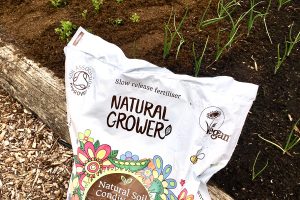As we come into the full swing of harvesting season, with tomatoes forming, beans and peas cropping, sweetcorn cobs developing and so on, it’s time to start feeding plants regularly.
Vegetable plants need a lot of nutrients to be healthy. Giving your plants a liquid feed regularly during the summer is the best way to boost the nutrients in the soil for your veggies. It will benefit all vegetable plants, but particularly those that produce fruits (courgettes, cucumber, tomatoes etc) and leafy crops (spinach, chard, salads.)
 It is easy to buy a liquid feed from the local garden centre or look online for an organic soil conditioner or organic liquid feed from seaweed. Another option, and one we prefer to suggest as there is no plastic packaging involved, is to make your own liquid feed at home. There are three easy ways you can do this, listed below:
It is easy to buy a liquid feed from the local garden centre or look online for an organic soil conditioner or organic liquid feed from seaweed. Another option, and one we prefer to suggest as there is no plastic packaging involved, is to make your own liquid feed at home. There are three easy ways you can do this, listed below:
Make a wormcast tea
This is fairly quick and easy, and a good option if you’re just watering a few crops using a watering can. Just mix 2 handfuls of wormcast fertiliser in a watering can, leave for 5 minutes and then stir really well before watering your crops.
Make a comfrey feed
Comfrey can be used as a brilliantly rich, natural fertiliser in organic growing. It draws loads of nitrogen and other nutrients from the soil and stores it all in its leaves. The leaves thus become an instant superfood for other plants and can be used to make a powerful liquid feed, a mulch, a compost accelerator and all sorts of other handy things.
To make a comfrey feed, wait until the plants reach approximately 80cm and then cut the leaves off to leave about 8cm growth on the plant. You can do this several times in the season, until September. Break the leaves up and pop them in a container of water. Leave the mixture, covered or under cover, for between 2 and 4 weeks until it turns a nice light tea colour (if it goes too dark just add more water as it’s a little over concentrated). It’ll become very stinky which is a sign that it’s rich and ready to use!
Use the liquid to feed your veg plants and then throw the rotten leaves into the compost heap, or use them as a mulch.
Make a nettle feed
This is a good idea for those who have patches of nettles growing in corners of the garden. It’s a good way of cutting them back and making use of them rather than digging them up or strimming them to keep them under control.
It is made in the same way as a comfrey tea, described above. With long sleeves and gloves on, cut down your nettles and soak them in a bucket of water for about a week. The water then makes a very good liquid feed, full of nutrients for your veg. The soggy, wilted nettles can be added to the compost heap.
How often to feed plants?
For fruiting plants – beans, tomatoes, corn, squash etc – we’d suggest feeding them every fortnight from when they start to flower.
For leafy plants, like salads and spinach, a one-off liquid feed in midsummer should be enough to give them a boost.

